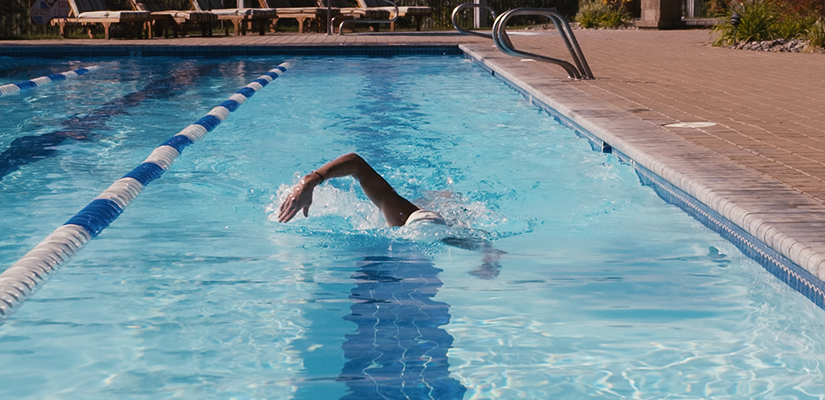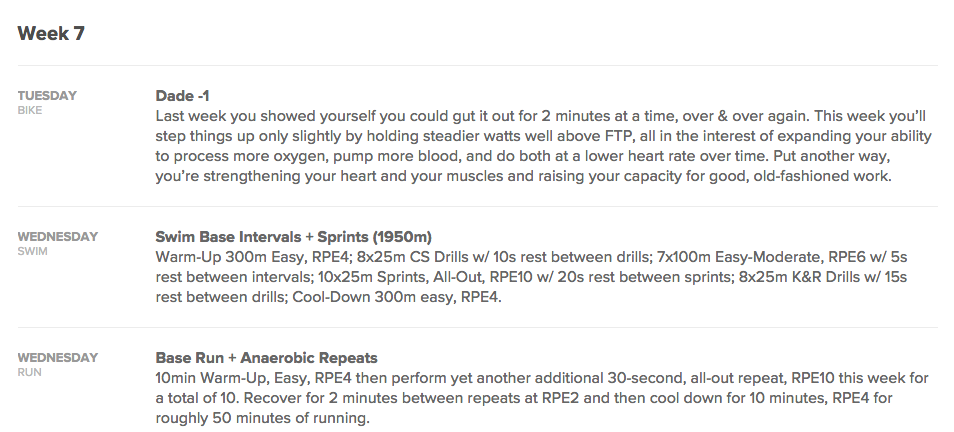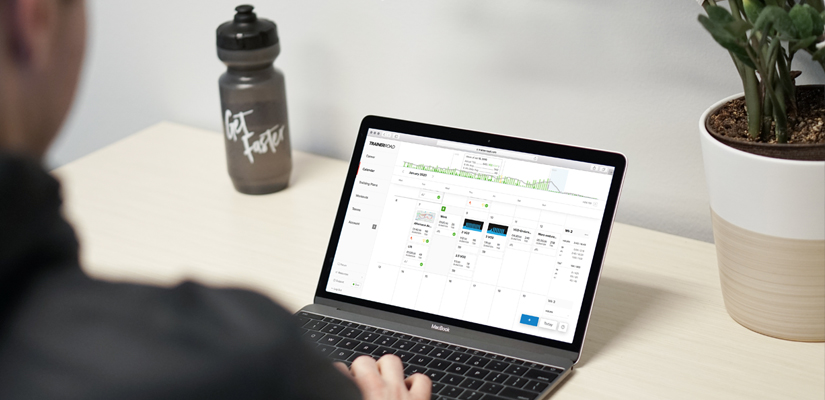Triathlon Training Plans: What’s Important & How to Choose the Right Plan
More than any other endurance sport, triathlon training is tough. Not only is it demanding on the body, but it can be complex. Choosing the right triathlon training plan typically requires research and a heavy-duty strategy if you want your time in the pool, on the bike, and on the pavement to be well spent. However, TrainerRoad removes the complication to ensure that you have the best triathlon training plan for you.
Why a Triathlon Training Plan is Important
Finding a solid triathlon training plan can be tricky. In one Google search, you’ll discover loads of plans—most of which simply scratch the surface of what you need to know to train for your tri event. While it can be tempting to choose just any plan, committing to a less-than-ideal triathlon training plan has some significant downfalls. At best, that random plan you found online can be a time-waster. At worst, it can be a season crusher.
Adaptive Training
Get the right workout, every time with training that adapts to you.
Check Out TrainerRoadFundamental to any endurance training is the repetition of stimulus, recovery, and adaptation. Properly structured triathlon training plans aim to progressively add just enough stress not to be utterly overwhelming while providing adequate rest that drives physiological changes. As a result, you become fitter and lessen the risk of overtraining or injury. The secret to a genuinely effective triathlon training plan is marrying the three disciplines into one program, seeing to it that your stress ramps up at the same tolerable rates across all your training.
The Goals of a Training Plan
Triathlon is widely considered the ultimate endurance sport, and rightly so. Triathlons of any distance require a robust aerobic energy system and significant muscular endurance. More than preparing the body, a training plan should also prepare you mentally for the challenge of holding your race pace.
Increasing Aerobic Base Fitness
The primary goal of a triathlon training plan is to develop your aerobic capacity. This means that you train your body to become more efficient at turning fuel (carbs and fat) into energy using oxygen. This transformation takes place within the mitochondria in your muscles. So, as you spend more time stressing your aerobic energy system, your body creates more mitochondria that are more efficient.
Improving Muscular Endurance
Muscular endurance is your ability to use your muscles repeatedly for long durations. In other words, muscular endurance is a measure of muscle fatigue over time. Your triathlon training plan needs to focus on improving your muscular endurance so you can finish strong. Developing this can be the difference between walking or running the final leg.
Mental Preparation
All triathlons are challenging, regardless of distance. But in general, the longer the triathlon, the greater the mental battle. Your triathlon training plan should give you the confidence needed to endure hours of racing. Throughout your training, you’ll become familiar with the discomfort of pushing the limits, which will pay off on race day.

Phases on a Triathlon Training Plan
Every TrainerRoad triathlon training plan includes three phases to make sure you are ready for your event. These are the Base, Build, and Speciality phases.
Base
The foundation of your season starts with base training. It’s in this phase that you’ll grow a broad aerobic base with a mix of swim, bike, and run workouts. Depending on your triathlon distance, this phase is 4-12 weeks long.
Our Triathlon Base training plans are designed from the ground up for multi-sport athletes. With workouts for swim, bike, and run disciplines, our goal is to help triathletes get as strong as possible for all aspects of their event.
Build
Triathlon Build training plans focus on building your fitness after your base foundation has been created. The Build Phase works to increase and sustain your threshold power by ensuring your workouts’ intensity and volume gradually trend upward from your Base Phase. Then, it focuses on building specific types of fitness for each discipline.
The Sprint Triathlon Build plan picks up where the Base Plan leaves off — with high intensity. The threshold and VO2 max intervals in this plan are sure to prepare you for the intense nature of sprint triathlons.
The Olympic Distance Build plan uses more high-intensity work while focusing on your ability to sustain these efforts. The versatility required by this discipline is addressed by first raising the intensity of your intervals and then stretching out the length of each interval as time goes on.
Although they are shorter than their full distance counterpart, half-distance triathlons are most definitely an endurance event. This plan places a premium on building your sustained power through progressively lengthening threshold intervals.
The natural assumption that full-distance triathlon training only requires moderate intensity is disproven with this plan. Twelve weeks of progressively increasing threshold and sweet spot work will prepare you to maintain a fast pace on race day.
Specialty
The Speciality Phase is all about refining your fitness for race day. With the necessary endurance & strength in the bank, the objective becomes growing as familiar as possible with the particular demands of racing. This phase offers a challenging mix of workouts that prepare you for your race-day pace.
How to Choose the Triathlon Training Plan That’s Right for You
If you need help deciding which triathlon training plan is best for you, there are a few things to consider. First, what distance triathlon are you going to do? This is an easy question. Once you know that, the second question is a bit more contemplative: how competitive do you want to be? There are the athletes who want to survive their event, there are the athletes who want to PR their event, and then there are the athletes who want to win the whole thing. Each of those goals necessitates a different degree of commitment and sacrifice.
Your answers to those two questions will help you choose the type and volume of a triathlon training plan. Choosing the type of plan is straightforward—it’s based on whether you are going for a sprint, Olympic, half-, or full-distance triathlon. When selecting a training plan volume, you should consider your goal and available training time.
That said, the magnitude of your goal doesn’t assume you should commit to a high-volume plan. You still need to consider your available training time and experience — there’s no reason you should jump into a high-volume plan just because you have the time and desire. Your optimal triathlon training plan takes into account your event, schedule, goals, and experience with endurance sports.

How Does Training Differ for Each Distance?
Yes, all triathlons include swim, bike, and run legs, but how those races play out are quite different. A simple example of the differing demands is seen in comparing sprint and half-distance triathlons. During a sprint triathlon, your race is completed before you’re halfway into the bike leg of a half-distance.
Add to this the objectives of building proper fitness in three different endurance sports. Additionally, you’ll train to build fitness in ways that task the different energy systems in slightly noticeable ways, inflicting different strains on your bones, muscles, and mind.
So it’s plain to see that the type of conditioning necessary to excel in one distance isn’t necessarily the kind you’d need for another. And while overlaps exist, the differences in the training and the necessary time commitments within the same sport present an interesting challenge for athletes & coaches alike, whether you’re just looking to finish or excel come event day.
As you skim through the plans, you’ll notice that each plan varies in volume and intensity. As the events get longer, it’s evident there’s a shift in balance towards more training volume and a little less training intensity.
Sprint Triathlon Plans
Sprint Base
Low Volume
- 4 weeks
- Swim: 34-40 Min/Wk
- Bike: 89-127 TSS/Wk
- Run: 50-60 Min/Wk
Mid Volume
- 4 weeks
- Swim: 91-109 Min/Wk
- Bike: 170-230 TSS/Wk
- Run: 105-130 Min/Wk
High Volume
- 4 weeks
- Swim: 130-210 Min/Wk
- Bike: 219-332 TSS/Wk
- Run: 177-200 Min/Wk
Sprint Build
Low Volume
- 4 weeks
- Swim: 51-60 Min/Wk
- Bike: 116-150 TSS/Wk
- Run: 60-80 Min/Wk
Mid Volume
- 4 weeks
- Swim: 99-116 Min/Wk
- Bike: 179-280 TSS/Wk
- Run: 130-150 Min/Wk
High Volume
- 4 weeks
- Swim: 136-210 Min/Wk
- Bike: 250-337 TSS/Wk
- Run: 170-230 Min/Wk
Sprint Specialty
Low Volume
- 8 weeks
- Swim: 53-63 Min/Wk
- Bike: 104-179 TSS/Wk
- Run: 75-105 Min/Wk
Mid Volume
- 8 weeks
- Swim: 73-130 Min/Wk
- Bike: 193-304 TSS/Wk
- Run: 95-185 Min/Wk
High Volume
- 8 weeks
- Swim: 131-232 Min/Wk
- Bike: 207-374 TSS/Wk
- Run: 130-246 Min/Wk
Olympic Triathlon Plans
Olympic Base
Low Volume
- 6 weeks
- Swim: 46-61 Min/Wk
- Bike: 126-152 TSS/Wk
- Run: 70-105 Min/Wk
Mid Volume
- 6 weeks
- Swim: 92-116 Min/Wk
- Bike: 154-208 TSS/Wk
- Run: 125-175 Min/Wk
High Volume
- 6 weeks
- Swim: 161-191 Min/Wk
- Bike: 231-359 TSS/Wk
- Run: 155-195 Min/Wk
Olympic Build
Low Volume
- 6 weeks
- Swim: 53-72 Min/Wk
- Bike: 157-312 TSS/Wk
- Run: 70-125 Min/Wk
Mid Volume
- 6 weeks
- Swim: 113-152 Min/Wk
- Bike: 251-314 TSS/Wk
- Run: 125-175 Min/Wk
High Volume
- 6 weeks
- Swim: 192-236 Min/Wk
- Bike: 304-376 TSS/Wk
- Run: 150-235 Min/Wk
Olympic Specialty
Low Volume
- 8 weeks
- Swim: 54-79 Min/Wk
- Bike: 80-202 TSS/Wk
- Run: 55-140 Min/Wk
Mid Volume
- 8 weeks
- Swim: 66-164 Min/Wk
- Bike: 134-334 TSS/Wk
- Run: 85-200 Min/Wk
High Volume
- 8 weeks
- Swim: 125-256 Min/Wk
- Bike: 194-431 TSS/Wk
- Run: 116-260 Min/Wk
Half-Distance Triathlon Plans
Half-Distance Base
Low Volume
- 8 weeks
- Swim: 84-123 Min/Wk
- Bike: 186-298 TSS/Wk
- Run: 85-160 Min/Wk
Mid Volume
- 8 weeks
- Swim: 99-132 Min/Wk
- Bike: 216-394 TSS/Wk
- Run: 135-190 Min/Wk
High Volume
- 8 weeks
- Swim: 146-204 Min/Wk
- Bike: 258-442 TSS/Wk
- Run: 160-225 Min/Wk
Half-Distance Build
Low Volume
- 8 weeks
- Swim: 99-150 Min/Wk
- Bike: 255-406 TSS/Wk
- Run: 105-205 Min/Wk
Mid Volume
- 8 weeks
- Swim: 120-156 Min/Wk
- Bike: 253-401 TSS/Wk
- Run: 160-225 Min/Wk
High Volume
- 8 weeks
- Swim: 177-238 Min/Wk
- Bike: 286-415 TSS/Wk
- Run: 180-270 Min/Wk
Half-Distance Speciality
Low Volume
- 8 weeks
- Swim: 53-160 Min/Wk
- Bike: 150-279 TSS/Wk
- Run: 55-135 Min/Wk
Mid Volume
- 8 weeks
- Swim: 63-171 Min/Wk
- Bike: 171-377 TSS/Wk
- Run: 90-280 Min/Wk
High Volume
- 8 weeks
- Swim: 106-250 Min/Wk
- Bike: 187-384 TSS/Wk
- Run: 90-350 Min/Wk
Full-Distance Triathlon Plans
Full-Distance Base
Low Volume
- 12 weeks
- Swim: 95-154 Min/Wk
- Bike: 186-372 TSS/Wk
- Run: 90-215 Min/Wk
Mid Volume
- 12 weeks
- Swim: 103-179 Min/Wk
- Bike: 196-452 TSS/Wk
- Run: 150-250 Min/Wk
High Volume
- 12 weeks
- Swim: 158-243 Min/Wk
- Bike: 278-565 TSS/Wk
- Run: 170-285 Min/Wk
Full-Distance Build
Low Volume
- 8 weeks
- Swim: 113-180 Min/Wk
- Bike: 295-354 TSS/Wk
- Run: 140-260 Min/Wk
Mid Volume
- 8 weeks
- Swim: 134-204 Min/Wk
- Bike: 304-474 TSS/Wk
- Run: 210-300 Min/Wk
High Volume
- 8 weeks
- Swim: 176-268 Min/Wk
- Bike: 296-495 TSS/Wk
- Run: 215-325 Min/Wk
Full-Distance Speciality
Low Volume
- 8 weeks
- Swim: 54-196 Min/Wk
- Bike: 134-392 TSS/Wk
- Run: 60-290 Min/Wk
Mid Volume
- 8 weeks
- Swim: 62-223 Min/Wk
- Bike: 172-500 TSS/Wk
- Run: 85-375 Min/Wk
High Volume
- 8 weeks
- Swim: 98-298 Min/WK
- Bike: 252-548 TSS/WK
- Run: 85-390 Min/Wk
The Mission Behind Our Triathlon Training Plans
From the very start, our mission at TrainerRoad has been to make you faster. That means we focus on education, not just conditioning. Our triathlon training plans include detailed swim, bike, and run instructions. Regardless of distance, every triathlon training plan comes with plan descriptions, weekly breakdowns, tips, and helpful coaching insights scattered throughout from Coach Chad.

TrainerRoad’s Philosophy to Triathlon Training
Our philosophy for effective triathlon training is marrying the three disciplines into one plan. That way, your stress ramps up at the same tolerable rates across all your training. Additionally, all three training disciplines should work together so you can rest assured that you are getting the right workouts on the right days. But an effective triathlon training plan is also built around you, your goals, and events. We divide the triathlon plans by distance and training volume to get a plan that is just right for you.
What Is Included in a TrainerRoad Triathlon Training Plan?
TrainerRoad’s triathlon plans include everything you need to be a faster triathlete. With our planning, training, and analysis tools, you’ll be ready to crush your goal event. Each triathlon training plan includes detailed swimming, cycling, and running workouts.
You can complete the bike workouts using the TrainerRoad App. All swim workouts use RPE (Rate of Perceived Exertion) and distance to quantify each interval. The run workouts use RPE and time. While there are plenty of other ways to quantify your work in those sports, these tools are widely available and allow the type of precision and flexibility needed to prescribe quality workouts to each of you.

TrainerRoad’s Triathlon Training Plans
The best way to get started with a triathlon training plan is to use Plan Builder. Plan Builder is an automated planning tool that takes the guesswork out of planning and helps you achieve peak fitness in time for your triathlon. It takes into account your current training volume, experience, and the demands of your chosen distance to create the optimal plan for you.
Sprint Triathlon Training Plan
Whether it’s your first triathlon or you are a seasoned multisport athlete, this plan will improve your swim, bike, and run splits. With 16 weeks of progressive training, you will cultivate a solid foundation of fitness, build muscular endurance, and fine-tune your training for your event.
Olympic Triathlon Training Plan
Whether you are simply inspired by the Olympic-distance format or making the upward leap from a Sprint Triathlon, longer distances require a bit more training than the latter to help develop your threshold power across three disciplines. To prepare for your Olympic-distance event, you’ll train through the Base, Build, and Speciality over a total of 20 weeks of training.
Half-Distance Triathlon Training Plan
Although they are shorter than their full distance counterpart, half-distance triathlons are most definitely an endurance event. Over 24 weeks, this plan places a premium on building your sustained power through progressively lengthening threshold intervals.
Full-Distance Triathlon Training Plan
Over 36 weeks, you’ll build what you need for all-day endurance. Increase your performance with easy to follow instructions, power-based bike workouts, and technique drills.
For more cycling training knowledge, listen to Ask a Cycling Coach — the only podcast dedicated to making you a faster cyclist. New episodes are released weekly.
